Profiles of Alaska Highway Communities Visited for Oral History Interviews
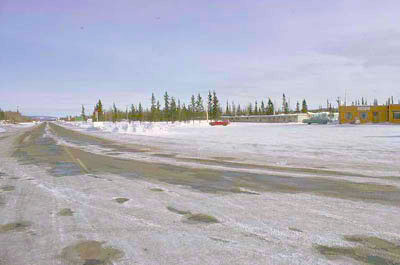 TOK
TOK
Tok is located at the junction of the Alaska and Glenn Highways, about 90 miles from the Canadian border, and 200 miles from Fairbanks. Tok is often considered the “Gateway to Alaska,” because it is the first major community located on the Alaska Highway after crossing the border to Alaska. The U.S. Customs office was located there from 1947 to 1971, when it was decided that Alaska residents would be better served if customs were moved to the border.
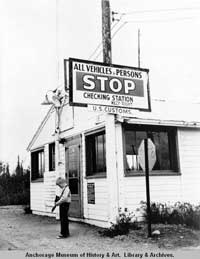 Tok represents the center of commerce and business in the Upper Tanana area, and its population of over 1000 indicates that it is also the largest community in terms of population. (Darbyshire and Associates, Northwest Alaskan Pipeline Company. “Socioeconomic Community Profiles; A Background for Planning.” Research Design Productions. June, 1980).
Tok represents the center of commerce and business in the Upper Tanana area, and its population of over 1000 indicates that it is also the largest community in terms of population. (Darbyshire and Associates, Northwest Alaskan Pipeline Company. “Socioeconomic Community Profiles; A Background for Planning.” Research Design Productions. June, 1980).
For more information about Tok from the State of Alaska, see: https://dcced.maps.arcgis.com/apps/MapJournal/index.html?appid=2d60770ccd45411186bf78d22f06d867;
For more about the history of the Alaska Highway and highway communities in Alaska, see https://www.explorenorth.com/communities.html
Books with more information about Tok:
~ Blasor-Bernhardt, Donna. “Tok: the real story: The Story of Tok, Dynamite and How Tok got it's Name.” Winter Cabin Production, Tok Alaska. March 1996.
~ Huber, Thomas P., Carole J. Huber. “The Alaska Highway: A Geographical Discovery.” University Press of Colorado, 2000.
~ Darbyshire and Associates. “Socioeconomic Community Profiles: A Background for Planning.” Alaska Pipeline Company, June 1980.
~ Maschmeyer, Gloria J., Alissa Crandall. “Along the Alaska Highway.” Alaska Northwest Books. 1991.
~ Stone, Ted. “Alaska and Yukon History Along the Highway: A Traveler's Guide to the Fascinating Facts, Intriguing Incidents and Lively Legends in Alaska's and Yukon's Past.” Red Deer College Press. 1997.
~ Brown, Tricia. “The World-Famous Alaska Highway: A Guide to the Alcan and Other Wilderness Roads of the North.” Fulcrum Publishing, Golden, Colorado. 2000.
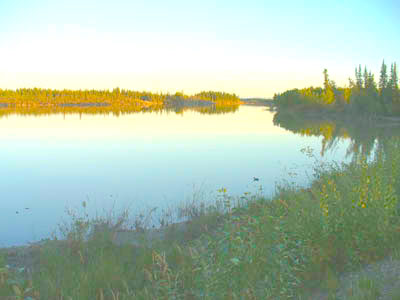 NORTHWAY
NORTHWAY
Residents of Northway generally consider themselves to belong to either the Indian "Fish Camp," which consists of widely spaced homes along the Northway Road, or the Northway Village, which is more tightly collected and closer to the airport, post office and other facilities. The area around Northway was originally settled by Athabaskan Indians who pursued seasonal subsistence activities in the vicinity of Scottie and Gardiner Creeks and the Chisana, Nabesna and Tanana Rivers. Northway, originally called Nabesna was the first settlement in the area, on the Nabesna River, across from present day Northway Village. The village moved to its present location in the 1940s due to flooding problems and the coming of the Alaska Highway. Men wanted jobs working on the airstrip and highway, and families wanted to be closer to the transportation route offered by the highway. It was not until January 1, 1942 that Nabesna adopted the name Northway, in honor of chief Walter Northway, or T'aiy Ta'. The population of Northway has fluctuated since the first census was taken in 1950, when the population was 196. By 1960, it had grown to 237; in 1970 it was 234; in 1980 it was 324 with two thirds of the population being Native. The current population of Northway hovers around 87, but that number excludes the “Fish Camp” area. (Darbyshire and Associates, Northwest Alaskan Pipeline Company. “Socioeconomic Community Profiles; A Background for Planning.” Research Design Productions. June, 1980).
Books with more information about Northway
:
~ Gallen, Ada. “Basket Making by a Northway Athabascan.” Alaska Gateway School District, Tok Alaska. December 1979.
~ Yarber, Yvonne, Curt Madison (beds.) “Walter Northway.” Alaska Native Language Center, University of Alaska Fairbanks. 1987.
~ Mobley, Charles M. “Archaeological Surveys for Airport Improvements, Northway, Alaska. Charles Mobley and Associates, Anchorage Alaska, 2005.
~ Huber, Thomas P., Carole J. Huber. “The Alaska Highway: A Geographical Discovery.” University Press of Colorado, 2000.
~ Darbyshire and Associates. “Socioeconomic Community Profiles: A Background for Planning.” Alaska Pipeline Company, June 1980.
~ Maschmeyer, Gloria J., Alissa Crandall. “Along the Alaska Highway.” Alaska Northwest Books. 1991.
~ Stone, Ted. “Alaska and Yukon History Along the Highway: A Traveler's Guide to the Fascinating Facts, Intriguing Incidents and Lively Legends in Alaska's and Yukon's Past.” Red Deer College Press. 1997.
~ Brown, Tricia. “The World-Famous Alaska Highway: A Guide to the Alcan and Other Wilderness Roads of the North.” Fulcrum Publishing, Golden, Colorado. 2000.
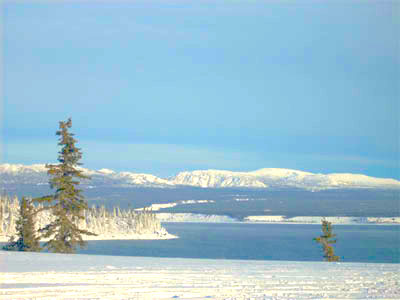 DESTRUCTION BAY
DESTRUCTION BAY
Along the western shore of Kluane Lake, the largest lake in the Yukon, are two of the territory's smaller communities, Burwash Landing and Destruction Bay. The communities are located in the Shakwak Valley, on the perimeter of Kluane National Park and the Tachal Region. Destruction Bay is on the highway, 19 km southeast of Burwash Landing and slightly closer to Haines Junction.
The town was established as a center for construction and maintenance on the Alaska Highway, and that remains its primary role today. The community of Destruction Bay earned its name from the high winds that buffet the area and destroyed buildings during the construction of the highway. The population as of 2005 was 59, mostly non-aboriginal. Its neighbor community, Burwash Landing, is the home of the Kluane First Nation of the Southern Tuchone People.
For more information, see: https://www.travelyukon.com/en/discover-yukon/regions-communities/destruction-bay
Books with more information about Destruction Bay:
~ Huber, Thomas P., Carole J. Huber. “The Alaska Highway: A Geographical Discovery.” University Press of Colorado, 2000.
~ Maschmeyer, Gloria J., Alissa Crandall. “Along the Alaska Highway.” Alaska Northwest Books, 1991.
~ Stone, Ted. “Alaska and Yukon History Along the Highway: A Traveler's Guide to the Fascinating Facts, Intriguing Incidents and Lively Legends in Alaska's and Yukon's Past.” Red Deer College Press, 1997.
~ Brown, Tricia. “The World-Famous Alaska Highway: A Guide to the Alcan and Other Wilderness Roads of the North.” Fulcrum Publishing, Golden, Colorado. 2000.
WHITEHORSE
Whitehorse is the beautiful capital of Yukon Territory, and has a population of around 30,372 (Statistics Canada, 2006 Census). Its history is exciting, due to the Klondike Gold Rush of 1898. Whitehorse was founded in 1900 and became the major jumping off point for miners and prospectors on their way to the gold fields. At this time, there were under 1000 people living there. The capital was Dawson City, and it was more focused on mining, and the White Pass and Yukon Railroad train depot.
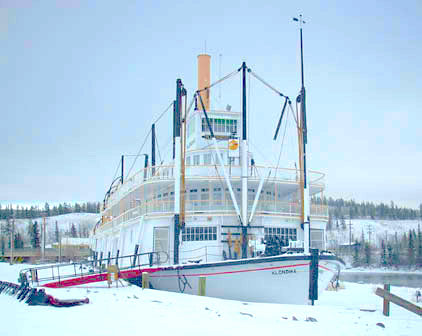 Following the completion of the highway, economic activity and the population shifted from Dawson to Whitehorse, and it became the capital on April 1, 1953. The city's location on the Yukon River and the Alaska Highway serves as the economic and traveling hub for the rest of the Yukon, and welcomes thousands of visitors every year. Though much of the Yukon remains wilderness, Whitehorse is a thriving arts and scholarly community.
Following the completion of the highway, economic activity and the population shifted from Dawson to Whitehorse, and it became the capital on April 1, 1953. The city's location on the Yukon River and the Alaska Highway serves as the economic and traveling hub for the rest of the Yukon, and welcomes thousands of visitors every year. Though much of the Yukon remains wilderness, Whitehorse is a thriving arts and scholarly community.
Websites with more information about Whitehorse:
Yukon Archives: https://yukon.ca/archives
City of Whitehorse: https://www.whitehorse.ca/
Canadian Government Site: https://yukon.ca/
Books with more information about Whitehorse:
~ Huber, Thomas P., Carole J. Huber. “The Alaska Highway: A Geographical Discovery.” University Press of Colorado, 2000.
~ Maschmeyer, Gloria J., Alissa Crandall. “Along the Alaska Highway.” Alaska Northwest Books, 1991.
~ Stone, Ted. “Alaska and Yukon History Along the Highway: A Traveler's Guide to the Fascinating Facts, Intriguing Incidents and Lively Legends in Alaska's and Yukon's Past.” Red Deer College Press, 1997.
~ Brown, Tricia. “The World-Famous Alaska Highway: A Guide to the Alcan and Other Wilderness Roads of the North.” Fulcrum Publishing, Golden, Colorado, 2000.

